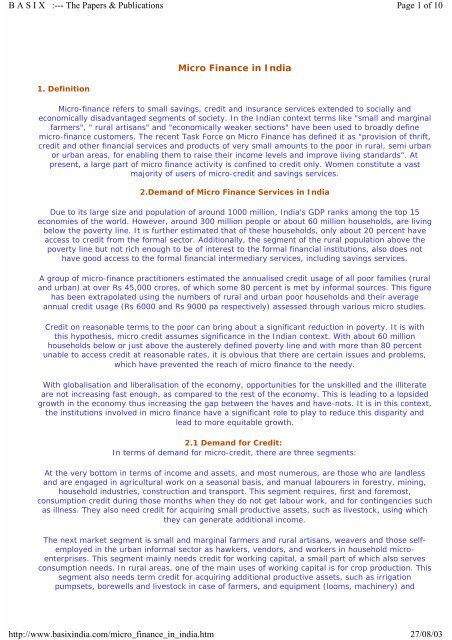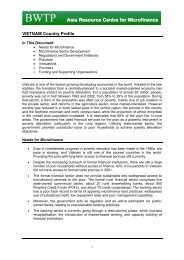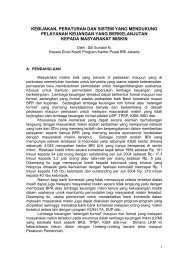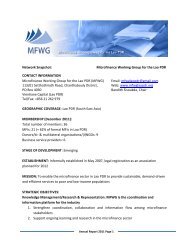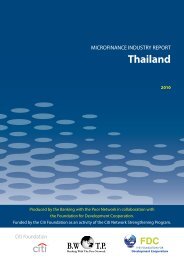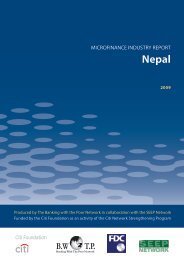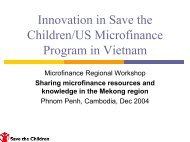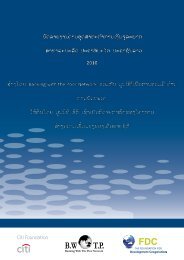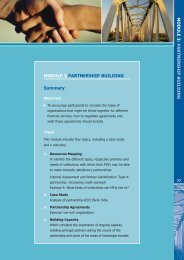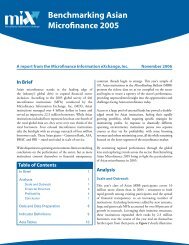Micro Finance in India - Banking with the Poor Network
Micro Finance in India - Banking with the Poor Network
Micro Finance in India - Banking with the Poor Network
You also want an ePaper? Increase the reach of your titles
YUMPU automatically turns print PDFs into web optimized ePapers that Google loves.
B A S I X :--- The Papers & Publications<br />
http://www.basix<strong>in</strong>dia.com/micro_f<strong>in</strong>ance_<strong>in</strong>_<strong>in</strong>dia.htm<br />
Page 1 of 10<br />
27/08/03<br />
<strong>Micro</strong> <strong>F<strong>in</strong>ance</strong> <strong>in</strong> <strong>India</strong><br />
1. Def<strong>in</strong>ition<br />
<strong>Micro</strong>-f<strong>in</strong>ance refers to small sav<strong>in</strong>gs, credit and <strong>in</strong>surance services extended to socially and<br />
economically disadvantaged segments of society. In <strong>the</strong> <strong>India</strong>n context terms like "small and marg<strong>in</strong>al<br />
farmers", " rural artisans" and "economically weaker sections" have been used to broadly def<strong>in</strong>e<br />
micro-f<strong>in</strong>ance customers. The recent Task Force on <strong>Micro</strong> <strong>F<strong>in</strong>ance</strong> has def<strong>in</strong>ed it as "provision of thrift,<br />
credit and o<strong>the</strong>r f<strong>in</strong>ancial services and products of very small amounts to <strong>the</strong> poor <strong>in</strong> rural, semi urban<br />
or urban areas, for enabl<strong>in</strong>g <strong>the</strong>m to raise <strong>the</strong>ir <strong>in</strong>come levels and improve liv<strong>in</strong>g standards". At<br />
present, a large part of micro f<strong>in</strong>ance activity is conf<strong>in</strong>ed to credit only. Women constitute a vast<br />
majority of users of micro-credit and sav<strong>in</strong>gs services.<br />
2.Demand of <strong>Micro</strong> <strong>F<strong>in</strong>ance</strong> Services <strong>in</strong> <strong>India</strong><br />
Due to its large size and population of around 1000 million, <strong>India</strong>'s GDP ranks among <strong>the</strong> top 15<br />
economies of <strong>the</strong> world. However, around 300 million people or about 60 million households, are liv<strong>in</strong>g<br />
below <strong>the</strong> poverty l<strong>in</strong>e. It is fur<strong>the</strong>r estimated that of <strong>the</strong>se households, only about 20 percent have<br />
access to credit from <strong>the</strong> formal sector. Additionally, <strong>the</strong> segment of <strong>the</strong> rural population above <strong>the</strong><br />
poverty l<strong>in</strong>e but not rich enough to be of <strong>in</strong>terest to <strong>the</strong> formal f<strong>in</strong>ancial <strong>in</strong>stitutions, also does not<br />
have good access to <strong>the</strong> formal f<strong>in</strong>ancial <strong>in</strong>termediary services, <strong>in</strong>clud<strong>in</strong>g sav<strong>in</strong>gs services.<br />
A group of micro-f<strong>in</strong>ance practitioners estimated <strong>the</strong> annualised credit usage of all poor families (rural<br />
and urban) at over Rs 45,000 crores, of which some 80 percent is met by <strong>in</strong>formal sources. This figure<br />
has been extrapolated us<strong>in</strong>g <strong>the</strong> numbers of rural and urban poor households and <strong>the</strong>ir average<br />
annual credit usage (Rs 6000 and Rs 9000 pa respectively) assessed through various micro studies.<br />
Credit on reasonable terms to <strong>the</strong> poor can br<strong>in</strong>g about a significant reduction <strong>in</strong> poverty. It is <strong>with</strong><br />
this hypo<strong>the</strong>sis, micro credit assumes significance <strong>in</strong> <strong>the</strong> <strong>India</strong>n context. With about 60 million<br />
households below or just above <strong>the</strong> austerely def<strong>in</strong>ed poverty l<strong>in</strong>e and <strong>with</strong> more than 80 percent<br />
unable to access credit at reasonable rates, it is obvious that <strong>the</strong>re are certa<strong>in</strong> issues and problems,<br />
which have prevented <strong>the</strong> reach of micro f<strong>in</strong>ance to <strong>the</strong> needy.<br />
With globalisation and liberalisation of <strong>the</strong> economy, opportunities for <strong>the</strong> unskilled and <strong>the</strong> illiterate<br />
are not <strong>in</strong>creas<strong>in</strong>g fast enough, as compared to <strong>the</strong> rest of <strong>the</strong> economy. This is lead<strong>in</strong>g to a lopsided<br />
growth <strong>in</strong> <strong>the</strong> economy thus <strong>in</strong>creas<strong>in</strong>g <strong>the</strong> gap between <strong>the</strong> haves and have-nots. It is <strong>in</strong> this context,<br />
<strong>the</strong> <strong>in</strong>stitutions <strong>in</strong>volved <strong>in</strong> micro f<strong>in</strong>ance have a significant role to play to reduce this disparity and<br />
lead to more equitable growth.<br />
2.1 Demand for Credit:<br />
In terms of demand for micro-credit, <strong>the</strong>re are three segments:<br />
At <strong>the</strong> very bottom <strong>in</strong> terms of <strong>in</strong>come and assets, and most numerous, are those who are landless<br />
and are engaged <strong>in</strong> agricultural work on a seasonal basis, and manual labourers <strong>in</strong> forestry, m<strong>in</strong><strong>in</strong>g,<br />
household <strong>in</strong>dustries, construction and transport. This segment requires, first and foremost,<br />
consumption credit dur<strong>in</strong>g those months when <strong>the</strong>y do not get labour work, and for cont<strong>in</strong>gencies such<br />
as illness. They also need credit for acquir<strong>in</strong>g small productive assets, such as livestock, us<strong>in</strong>g which<br />
<strong>the</strong>y can generate additional <strong>in</strong>come.<br />
The next market segment is small and marg<strong>in</strong>al farmers and rural artisans, weavers and those selfemployed<br />
<strong>in</strong> <strong>the</strong> urban <strong>in</strong>formal sector as hawkers, vendors, and workers <strong>in</strong> household microenterprises.<br />
This segment ma<strong>in</strong>ly needs credit for work<strong>in</strong>g capital, a small part of which also serves<br />
consumption needs. In rural areas, one of <strong>the</strong> ma<strong>in</strong> uses of work<strong>in</strong>g capital is for crop production. This<br />
segment also needs term credit for acquir<strong>in</strong>g additional productive assets, such as irrigation<br />
pumpsets, borewells and livestock <strong>in</strong> case of farmers, and equipment (looms, mach<strong>in</strong>ery) and
B A S I X :--- The Papers & Publications<br />
http://www.basix<strong>in</strong>dia.com/micro_f<strong>in</strong>ance_<strong>in</strong>_<strong>in</strong>dia.htm<br />
Page 2 of 10<br />
27/08/03<br />
worksheds <strong>in</strong> case of non-farm workers. This market segment also largely comprises <strong>the</strong> poor but not<br />
<strong>the</strong> poorest.<br />
The third market segment is of small and medium farmers who have gone <strong>in</strong> for commercial crops<br />
such as surplus paddy and wheat, cotton, groundnut, and o<strong>the</strong>rs engaged <strong>in</strong> dairy<strong>in</strong>g, poultry, fishery,<br />
etc. Among non-farm activities, this segment <strong>in</strong>cludes those <strong>in</strong> villages and slums, engaged <strong>in</strong><br />
process<strong>in</strong>g or manufactur<strong>in</strong>g activity, runn<strong>in</strong>g provision stores, repair workshops, tea shops, and<br />
various service enterprises. These persons are not always poor, though <strong>the</strong>y live barely above <strong>the</strong><br />
poverty l<strong>in</strong>e and also suffer from <strong>in</strong>adequate access to formal credit.<br />
One market segment, which is of great importance to micro-credit is women. The 1991 Census figures<br />
reveal that out of total 2.81 million marg<strong>in</strong>al workers, 2.54 million were women and <strong>the</strong>ir fur<strong>the</strong>r<br />
break-up shows that out of a total of 2.67 million rural marg<strong>in</strong>al workers, 2.44 million were females.<br />
Fur<strong>the</strong>r, many more women were will<strong>in</strong>g to work. This has been corroborated by <strong>the</strong> results of a<br />
survey done by <strong>the</strong> National Sample Survey Organisation (NSSO), 43 rd round, which has revealed that<br />
<strong>the</strong>re is a vide variety of work which rural women comb<strong>in</strong>e <strong>with</strong> household work.<br />
In <strong>the</strong> NSSO survey it has also been estimated that a large percentage of rural women <strong>in</strong> <strong>the</strong> age<br />
group of 15 years and above, who are usually engaged <strong>in</strong> household work, are will<strong>in</strong>g to accept work<br />
at household premises (29.3 percent), <strong>in</strong> activities such as dairy (9.5 percent), poultry (3 percent),<br />
cattle rear<strong>in</strong>g, sp<strong>in</strong>n<strong>in</strong>g and weav<strong>in</strong>g (3.4 percent), tailor<strong>in</strong>g (6.1 percent) and manufactur<strong>in</strong>g of wood<br />
and cane products etc. Amongst <strong>the</strong> women surveyed, 27.5 percent rural women were seek<strong>in</strong>g regular<br />
full-time work, and 65.3 percent were seek<strong>in</strong>g part-time work. To start or to carry on such work, 53.6<br />
percent women wanted <strong>in</strong>itial f<strong>in</strong>ance on easy terms, and 22.2 percent wanted work<strong>in</strong>g capital<br />
facilities, as can be seen from <strong>the</strong> table below:<br />
Assistance Required (by women<br />
marg<strong>in</strong>al workers seek<strong>in</strong>g or available<br />
for work at <strong>the</strong>ir household premises).<br />
Percent of<br />
Women Seek<strong>in</strong>g<br />
Assistance<br />
No assistance 2.1<br />
Initial f<strong>in</strong>ance on easy terms 53.6<br />
Work<strong>in</strong>g capital facilities 22.2<br />
Raw materials availability 4.6<br />
Market<strong>in</strong>g 1.7<br />
Tra<strong>in</strong><strong>in</strong>g 10.5<br />
Accommodation 0.4<br />
O<strong>the</strong>r assistance 4.9<br />
Total 100<br />
2. Demand for Sav<strong>in</strong>gs and Insurance Services:<br />
The demand for sav<strong>in</strong>gs services is ever higher than for credit. Studies of rural households <strong>in</strong> various<br />
states <strong>in</strong> <strong>India</strong> show that <strong>the</strong> poor, particularly women, are look<strong>in</strong>g for a way to save small amounts<br />
whenever <strong>the</strong>y can. The irregularity of cashflows and <strong>the</strong> small amounts available for sav<strong>in</strong>gs at one<br />
time, deter <strong>the</strong>m from us<strong>in</strong>g formal channels such as banks. In urban areas also this is true, <strong>in</strong> spite of
B A S I X :--- The Papers & Publications<br />
http://www.basix<strong>in</strong>dia.com/micro_f<strong>in</strong>ance_<strong>in</strong>_<strong>in</strong>dia.htm<br />
Page 3 of 10<br />
27/08/03<br />
better bank<strong>in</strong>g facilities, as shown by <strong>the</strong> experience of <strong>the</strong> SEWA Bank, Ahmedabad. The poor want<br />
to save for various reasons – as a cushion aga<strong>in</strong>st cont<strong>in</strong>gencies like illness, calamities, death <strong>in</strong> <strong>the</strong><br />
family, etc; as a source of equity or marg<strong>in</strong> to take loans; and f<strong>in</strong>ally, as a liquid asset. The safety of<br />
sav<strong>in</strong>gs is of higher concern than <strong>in</strong>terest rates. The demand for sav<strong>in</strong>gs services is high <strong>in</strong> rural areas<br />
as well, as can be seen from a recent study of women’s sav<strong>in</strong>gs and credit movement <strong>in</strong> Andhra<br />
Pradesh. Almost all women’s groups <strong>in</strong> <strong>the</strong>ir early years beg<strong>in</strong> <strong>with</strong> regular sav<strong>in</strong>gs and <strong>the</strong>ir sav<strong>in</strong>gs<br />
exceed <strong>the</strong> loans <strong>the</strong>y give from <strong>the</strong>ir funds. Of course, part of this lower demand for credit is <strong>the</strong><br />
<strong>in</strong>adequate absorption capacity of women, which comes from long years of exclusion from <strong>the</strong><br />
economic sphere outside <strong>the</strong>ir homes.<br />
The demand for <strong>in</strong>surance services, though not very well articulated, is also substantial. This comes<br />
from <strong>the</strong> fact that not only <strong>in</strong>comes of microf<strong>in</strong>ance customers low, but are also highly variable.<br />
Insurance by <strong>the</strong> poor is needed for assets such as livestock and pumpsets, for shelter. Crop <strong>in</strong>surance<br />
could be very useful to <strong>the</strong> rural poor. F<strong>in</strong>ally, <strong>in</strong>surance aga<strong>in</strong>st illness, disability and death would also<br />
reduce <strong>the</strong> shocks caused by such cont<strong>in</strong>gencies, which lead <strong>the</strong> poor <strong>in</strong>to tak<strong>in</strong>g loans at such times<br />
at high <strong>in</strong>terest.<br />
3.Supply of <strong>Micro</strong>-<strong>F<strong>in</strong>ance</strong> Services<br />
RBI data shows that <strong>in</strong>formal sources provide a significant part of <strong>the</strong> total credit needs of <strong>the</strong> rural<br />
population. The magnitude of <strong>the</strong> dependence of <strong>the</strong> rural poor on <strong>in</strong>formal sources of credit can be<br />
observed from <strong>the</strong> f<strong>in</strong>d<strong>in</strong>gs of <strong>the</strong> All <strong>India</strong> Debt and Investment Survey, 1992, which shows that <strong>the</strong><br />
share of <strong>the</strong> non-<strong>in</strong>stitutional agencies (<strong>in</strong>formal sector) <strong>in</strong> <strong>the</strong> outstand<strong>in</strong>g cash dues of <strong>the</strong> rural<br />
households was 36 percent. However, <strong>the</strong> dependence of rural households on such <strong>in</strong>formal sources<br />
had reduced of <strong>the</strong>ir total outstand<strong>in</strong>g dues steadily from 83.7 percent <strong>in</strong> 1961 to 36 percent <strong>in</strong> 1991.<br />
This is shown <strong>in</strong> <strong>the</strong> table below.<br />
Outstand<strong>in</strong>gs from Informal Sources as a Percentage of Total Dues,<br />
for Various Occupational Categories of Rural Households<br />
Year Cultivators Non-Cultivators All<br />
1961 81.6 89.5 83.7<br />
1971 60.3 89.2 70.8<br />
1981 36.8 63.3 38.8<br />
1991 33.7 44.7 36.0<br />
Among formal <strong>in</strong>stitutional sources, banks and co-operatives provided credit support to almost 56<br />
percent of <strong>the</strong> rural households, while professional and agricultural money lenders were provid<strong>in</strong>g<br />
credit to almost one sixth of <strong>the</strong> rural households. The details by source are given below:<br />
Sources of Credit for Rural Households, 1991<br />
Credit Agency<br />
% of Rural Households<br />
Government etc 6.1<br />
Cooperative Societies 21.6<br />
Commercial Banks and RRBs 33.7
B A S I X :--- The Papers & Publications<br />
http://www.basix<strong>in</strong>dia.com/micro_f<strong>in</strong>ance_<strong>in</strong>_<strong>in</strong>dia.htm<br />
Page 4 of 10<br />
27/08/03<br />
Insurance 0.3<br />
Provident Fund 0.7<br />
O<strong>the</strong>r <strong>in</strong>stitutional Sources 1.6<br />
All Institutional Agencies 64.0<br />
Landlord 4.0<br />
Agricultural Money-lenders 7.0<br />
Professional Money-lenders 10.5<br />
Relatives and Friends 5.5<br />
O<strong>the</strong>rs 9.0<br />
All Non-<strong>in</strong>stitutional Agencies 36.0<br />
All Agencies 100.0<br />
Though <strong>the</strong> overall share of <strong>in</strong>stitutional credit for rural households has gone up steadily, households<br />
<strong>in</strong> <strong>the</strong> lower asset groups were more dependent on <strong>the</strong> non-<strong>in</strong>stitutional credit agencies. The share of<br />
debt from <strong>the</strong> non-<strong>in</strong>stitutional credit agencies was 58 percent <strong>in</strong> <strong>the</strong> case of lowest asset group of<br />
"less than Rs 5,000" as aga<strong>in</strong>st a low of 19 percent <strong>in</strong> <strong>the</strong> highest asset group of " Rs 2.5 lakh and<br />
above".<br />
Share of Debt from Institutional and Non-<strong>in</strong>stitutional Sources,<br />
by Asset Hold<strong>in</strong>gs of Households<br />
Household Assets<br />
(Rs 000)<br />
Institutional<br />
Agency<br />
Share as %<br />
Non<strong>in</strong>stitutional<br />
Agency<br />
Share as %<br />
All<br />
Less than 5 42 58 100<br />
5-10 47 53 100<br />
10-20 44 56 100<br />
20-30 68 32 100<br />
30-50 55 45 100<br />
50-70 53 47 100<br />
70-100 61 39 100<br />
100-150 61 39 100
B A S I X :--- The Papers & Publications<br />
http://www.basix<strong>in</strong>dia.com/micro_f<strong>in</strong>ance_<strong>in</strong>_<strong>in</strong>dia.htm<br />
Page 5 of 10<br />
27/08/03<br />
150-250 68 32 100<br />
250 and above 81 19 100<br />
All Classes 64 36 100<br />
Over <strong>the</strong> decades follow<strong>in</strong>g <strong>India</strong>'s <strong>in</strong>dependence <strong>in</strong> 1947, Government of <strong>India</strong> (GOI) has made<br />
concerted efforts to provide micro-f<strong>in</strong>ance to <strong>the</strong> rural poor through <strong>the</strong> formal f<strong>in</strong>ancial sector namely<br />
<strong>the</strong> co-operatives. However, <strong>the</strong> limited success of <strong>the</strong> co-operatives <strong>in</strong> <strong>the</strong> mid fifties to <strong>the</strong> sixties<br />
forged <strong>the</strong> need for nationalisation of commercial banks (CB) <strong>in</strong> 1971 and <strong>the</strong> establishment of a large<br />
network to reach every village, and every segment of <strong>the</strong> population. In <strong>the</strong> mid-1970s, Regional<br />
Rural Banks (RRB) were also established to cont<strong>in</strong>ue fur<strong>the</strong>r <strong>the</strong> outreach of <strong>the</strong> bank<strong>in</strong>g sector <strong>in</strong><br />
reach<strong>in</strong>g <strong>the</strong> rural poor. All <strong>the</strong>se programs were supported by a policy of mandated credit programs<br />
for <strong>the</strong> low-<strong>in</strong>come households that were supported by <strong>the</strong> Integrated Rural Development Program<br />
(IRDP), launched <strong>in</strong> 1980. The IRDP was designed to provide a mix of subsidy from <strong>the</strong> government<br />
and credit from <strong>the</strong> bank<strong>in</strong>g system to enable <strong>the</strong> asset acquisition of <strong>the</strong> poor.<br />
As a result of <strong>the</strong>se programs, <strong>India</strong> has one of <strong>the</strong> largest bank<strong>in</strong>g networks <strong>in</strong> <strong>the</strong> world <strong>with</strong> close to<br />
50,000 CB outlets; 14,420 RRBs; and 90,000 primary agricultural co-operative societies. Close to 43<br />
percent of <strong>the</strong> CB, and RRB branches are located <strong>in</strong> <strong>the</strong> rural areas. Even more impressive is <strong>the</strong> fact<br />
that, <strong>the</strong>re is a f<strong>in</strong>ancial <strong>in</strong>termediary branch for every 15,000 households, and a co-operative <strong>in</strong> every<br />
village.<br />
Due to <strong>the</strong> extensive expansion of <strong>the</strong> bank<strong>in</strong>g network and emphasis on lend<strong>in</strong>g to small borrowers,<br />
<strong>the</strong>re have been a lot of small loans by banks. In terms of amount, this was 13.2 percent of <strong>the</strong> total<br />
credit outstand<strong>in</strong>g from commercial banks and RRBs. As per RBI data for March 1994, <strong>the</strong> number of<br />
accounts below Rs 25,000 was 5.6 million, or 93.6 percent of total loan accounts, <strong>with</strong> 18.6 percent of<br />
<strong>the</strong> outstand<strong>in</strong>g amount. Of <strong>the</strong>se, accounts <strong>with</strong> outstand<strong>in</strong>g below Rs 7500 comprised 80.5 percent<br />
of <strong>the</strong> number of accounts and 49.5 percent of amount outstand<strong>in</strong>g. In terms of purpose, 45.8 percent<br />
of amount was for small agricultural loans, 20.2 percent for <strong>in</strong>dustry and 18.8 percent for trade and<br />
services.<br />
By March 1997, <strong>the</strong> number of small borrowal accounts <strong>with</strong> a credit limit below Rs 25,000, had come<br />
down by as many 0.6 million accounts to 5.0 million, or 90.1 percent of <strong>the</strong> outstand<strong>in</strong>g loan accounts.<br />
This decl<strong>in</strong>e <strong>in</strong> number of accounts clearly shows <strong>the</strong> post liberalisation trend, <strong>with</strong> banks<br />
concentrat<strong>in</strong>g <strong>the</strong>ir efforts on larger loans and becom<strong>in</strong>g ever more reluctant to extend credit to small<br />
borrowers.<br />
While banks have been engaged <strong>in</strong> f<strong>in</strong>anc<strong>in</strong>g small borrowers, <strong>the</strong> manner <strong>in</strong> which this is be<strong>in</strong>g done<br />
can hardly be called micro-f<strong>in</strong>ance. The procedures are cumbersome, <strong>the</strong> staff unfriendly and <strong>the</strong><br />
transaction costs high. Repeat loans, except for crop production, are rare, even for borrowers who<br />
have repaid fully. Fur<strong>the</strong>rmore, even though <strong>the</strong> many of <strong>the</strong> loans extended to <strong>the</strong> poor by <strong>the</strong> public<br />
sector f<strong>in</strong>ancial <strong>in</strong>stitutions are subsidized, <strong>the</strong>ir ultimate cost to <strong>the</strong> borrowers is high: factor<strong>in</strong>g <strong>in</strong><br />
out-of-pocket costs, payments to middle men, wage and bus<strong>in</strong>ess loss due to time spent <strong>in</strong> gett<strong>in</strong>g <strong>the</strong><br />
loan approved. Effectively, <strong>the</strong> total cost of funds to <strong>the</strong> borrower ranges between 22–30 percent as<br />
aga<strong>in</strong>st <strong>the</strong> 12-14 percent nom<strong>in</strong>al lend<strong>in</strong>g rates specified for commercial bank loans below Rs<br />
200,000. All this results <strong>in</strong> low repayment rates, lead<strong>in</strong>g to a vicious cycle of non-availability and nonrepayment.<br />
Supply of Sav<strong>in</strong>gs and Insurance Services:<br />
In <strong>the</strong> case of sav<strong>in</strong>gs services, aga<strong>in</strong> while banks have provided access to a large number of small<br />
depositors, <strong>the</strong> demand is nowhere near be<strong>in</strong>g met, particularly for small , frequent "recurr<strong>in</strong>g"<br />
deposits. Hence <strong>the</strong> poor turn to o<strong>the</strong>r means such as chits, bishis and sav<strong>in</strong>gs mobilisation companies<br />
like Peerless and Sahara. Many such companies are fly-by night and as a result, <strong>the</strong> poor lose <strong>the</strong>ir<br />
money. The RBI has tightened up deposit tak<strong>in</strong>g activity s<strong>in</strong>ce 1997, but this has, perversely, also led<br />
to legitimate MFIs be<strong>in</strong>g not allowed to take deposits and thus provide sav<strong>in</strong>gs services to <strong>the</strong> poor.<br />
Transaction costs of sav<strong>in</strong>gs <strong>in</strong> formal <strong>in</strong>stitutions were as high as 10 percent for <strong>the</strong> rural poor,
B A S I X :--- The Papers & Publications<br />
http://www.basix<strong>in</strong>dia.com/micro_f<strong>in</strong>ance_<strong>in</strong>_<strong>in</strong>dia.htm<br />
Page 6 of 10<br />
27/08/03<br />
because of small average transaction size and distance of <strong>the</strong> bank from villages.<br />
The supply of <strong>in</strong>surance services to <strong>the</strong> poor has been <strong>in</strong>creased substantially over <strong>the</strong> 1990s, and<br />
<strong>the</strong>re are a large number of low premium schemes cover<strong>in</strong>g <strong>the</strong>m aga<strong>in</strong>st death, accidents, natural<br />
calamities, and loss of assets due to fire, <strong>the</strong>ft, etc. However, <strong>the</strong> usage is limited by low awareness<br />
among <strong>the</strong> poor. Crop and livestock <strong>in</strong>surance, however, are quite expensive and <strong>the</strong>ir reach to <strong>the</strong><br />
poor is negligible. Livestock and asset <strong>in</strong>surance was extended top <strong>the</strong> poor along <strong>with</strong> <strong>the</strong> IRDP<br />
subsidised loans, and thus rema<strong>in</strong>ed scheme driven, <strong>with</strong> little awareness among <strong>the</strong> customers.<br />
4. <strong>Micro</strong>-<strong>F<strong>in</strong>ance</strong> Institutional Structure:<br />
The different organisations <strong>in</strong> this field can be classified as "Ma<strong>in</strong>stream" and "Alternative" <strong>Micro</strong><br />
<strong>F<strong>in</strong>ance</strong> Institutions (MFI).<br />
4.1 Ma<strong>in</strong>stream <strong>Micro</strong> <strong>F<strong>in</strong>ance</strong> Institutions<br />
National Agricultural Bank for Rural Development (NABARD), Small Industries Development Bank of<br />
<strong>India</strong> (SIDBI), Hous<strong>in</strong>g Development <strong>F<strong>in</strong>ance</strong> Corporation (HDFC), Commercial Banks, Regional Rural<br />
Banks (RRBs), <strong>the</strong> credit co-operative societies etc are some of <strong>the</strong> ma<strong>in</strong>stream f<strong>in</strong>ancial <strong>in</strong>stitutions<br />
<strong>in</strong>volved <strong>in</strong> extend<strong>in</strong>g micro f<strong>in</strong>ance.<br />
4.2 Alternative <strong>Micro</strong> <strong>F<strong>in</strong>ance</strong> Institutions<br />
These are <strong>the</strong> <strong>in</strong>stitutions, which have come up to fill <strong>the</strong> gap between <strong>the</strong> demand and supply for<br />
microf<strong>in</strong>ance. MFIs were recently def<strong>in</strong>ed by <strong>the</strong> Task Force as "those which provide thrift, credit and<br />
o<strong>the</strong>r f<strong>in</strong>ancial services and products of very small amounts, ma<strong>in</strong>ly to <strong>the</strong> poor, <strong>in</strong> rural, semi-urban<br />
or urban areas for enabl<strong>in</strong>g <strong>the</strong>m to raise <strong>the</strong>ir <strong>in</strong>come level and improve liv<strong>in</strong>g standards." The MFIs<br />
can broadly be classified as:<br />
! NGOs, which are ma<strong>in</strong>ly engaged <strong>in</strong> promot<strong>in</strong>g self-help groups (SHGs) and <strong>the</strong>ir federations at<br />
a cluster level, and l<strong>in</strong>k<strong>in</strong>g SHGs <strong>with</strong> banks, under <strong>the</strong> NABARD scheme.<br />
! NGOs directly lend<strong>in</strong>g to borrowers, who are ei<strong>the</strong>r organised <strong>in</strong>to SHGs or <strong>in</strong>to Grameen Bank<br />
style groups and centres. These NGOs borrow bulk funds from RMK, SIDBI, FWWB and various<br />
donors.<br />
! MFIs which are specifically organised as cooperatives, such as <strong>the</strong> SEWA Bank and various<br />
Mutually Aided Cooperative Thrift and Credit Societies (MACTS) <strong>in</strong> AP.<br />
! MFIs, which are organised as non-bank<strong>in</strong>g f<strong>in</strong>ance companies, such as BASIX, CFTS, Mirzapur<br />
and SHARE <strong>Micro</strong>f<strong>in</strong> Ltd.<br />
Some of <strong>the</strong> lead<strong>in</strong>g alternative microf<strong>in</strong>ance <strong>in</strong>stitutions <strong>in</strong> this segment are SEWA Bank <strong>in</strong> Gujarat,<br />
which also runs federations of SHGs <strong>in</strong> n<strong>in</strong>e districts; ASSEFA and its Sarva Jana Seva Kosh Ltd, <strong>the</strong><br />
and ASA <strong>in</strong> Tamil Nadu: SHARE, BASIX, CARE and MACTs <strong>in</strong> AP promoted among o<strong>the</strong>rs by <strong>the</strong><br />
Cooperative Development Foundation (CDF); MYRADA <strong>in</strong> Karnataka, which has promoted<br />
Sanghamitra, a company of its village sav<strong>in</strong>gs and credit sanghas; PRADAN which has established a<br />
large number of SHGs and federated <strong>the</strong>m under Damodar <strong>in</strong> Bihar, Sakhi Samiti <strong>in</strong> Rajasthan and <strong>the</strong><br />
Kalanjiams <strong>in</strong> Tamil Nadu (<strong>the</strong> last now run by DHAN Foundation); ADITHI <strong>in</strong> Bihar has established<br />
Nari Nidhi, a federation of women’s groups; PREM <strong>in</strong> Orissa has done <strong>the</strong> same through <strong>the</strong> Utkal<br />
Mahila Sanchay O Bikas; <strong>the</strong> Rashtriya Gram<strong>in</strong> Vikas Nidhi which runs credit and sav<strong>in</strong>gs programs <strong>in</strong><br />
Assam and Orissa, on <strong>the</strong> l<strong>in</strong>es of <strong>the</strong> Grameen Bank, Bangladesh, as does SHARE <strong>in</strong> AP, ASA <strong>in</strong> Tamil<br />
Nadu and RDO <strong>in</strong> Manipur.<br />
5. The Problems Associated <strong>with</strong> Ma<strong>in</strong>stream MFIs
B A S I X :--- The Papers & Publications<br />
http://www.basix<strong>in</strong>dia.com/micro_f<strong>in</strong>ance_<strong>in</strong>_<strong>in</strong>dia.htm<br />
Page 7 of 10<br />
27/08/03<br />
To enable <strong>the</strong> reach of micro f<strong>in</strong>ance services to <strong>the</strong> needy, <strong>the</strong> problems associated <strong>with</strong> <strong>the</strong> legal,<br />
regulatory, organisational systems and <strong>the</strong> attitudes should be addressed to and <strong>the</strong> desired changes<br />
brought <strong>in</strong> <strong>the</strong>se, to make <strong>the</strong>m more effective.<br />
The ma<strong>in</strong>stream f<strong>in</strong>ancial <strong>in</strong>stitutions are flush <strong>with</strong> funds and have access to enormous amounts of<br />
low cost sav<strong>in</strong>gs deposits. Indeed, <strong>the</strong> poorer <strong>the</strong> region, <strong>the</strong> lower <strong>the</strong> credit deposit ratio – most of<br />
<strong>the</strong> eastern UP, Bihar, Orissa and <strong>the</strong> North-East have Credit Deposit ratios of 20-30 percent. Thus<br />
while banks are physically present <strong>in</strong> rural areas and offer concessional <strong>in</strong>terest rates, rural producers<br />
are not able to access, <strong>with</strong> <strong>the</strong> result that <strong>the</strong> rest of <strong>the</strong> deposits are f<strong>in</strong>d<strong>in</strong>g <strong>the</strong>ir way <strong>in</strong>to <strong>the</strong><br />
f<strong>in</strong>ancial sector. Some of <strong>the</strong> ma<strong>in</strong> reasons for <strong>the</strong> above are:<br />
5.1 Borrower Unfriendly Products and Procedures<br />
With a majority of <strong>the</strong> customers be<strong>in</strong>g illiterate, and a majority of <strong>the</strong>m need<strong>in</strong>g consumption loans<br />
and a majority of <strong>the</strong>m requir<strong>in</strong>g high documentation and collateral security, <strong>the</strong> products are not<br />
reach<strong>in</strong>g <strong>the</strong> rural poor.<br />
5.2 Inflexibility and Delay<br />
The rigid systems and procedures result <strong>in</strong> lot of time delay for <strong>the</strong> borrowers and de-motivate <strong>the</strong>m<br />
to take fur<strong>the</strong>r loans.<br />
5.3 High Transaction Costs, both Legitimate and Illegal<br />
Although <strong>the</strong> <strong>in</strong>terest rate offered to <strong>the</strong> borrowers is regulated, <strong>the</strong> transaction costs <strong>in</strong> terms of <strong>the</strong><br />
number of trips to be made, <strong>the</strong> documents to be furnished etc. plus <strong>the</strong> illegal charges to be paid,<br />
result <strong>in</strong> <strong>in</strong>creas<strong>in</strong>g <strong>the</strong> cost of borrow<strong>in</strong>g. Thus, mak<strong>in</strong>g it less attractive to <strong>the</strong> borrowers.<br />
5.4 Social Obligation and not a Bus<strong>in</strong>ess Opportunity<br />
<strong>Micro</strong>-f<strong>in</strong>ance has historically been seen as a social obligation ra<strong>the</strong>r than a potential bus<strong>in</strong>ess<br />
opportunity.<br />
5.5 F<strong>in</strong>anc<strong>in</strong>g to Alternative MFIs<br />
NABARD Act does not permit <strong>the</strong>m to ref<strong>in</strong>ance any private sector FI and do any direct f<strong>in</strong>anc<strong>in</strong>g<br />
(NABARD's direct lend<strong>in</strong>g to micro-f<strong>in</strong>ance NGOs so far has been out of donor funds), similarly SIDBI<br />
Act restricts it from extend<strong>in</strong>g loans to <strong>the</strong> agricultural and allied sectors, whereas many of <strong>the</strong><br />
members of <strong>the</strong> self help groups are engaged <strong>in</strong> such activities.<br />
5.6 Legal and Regulatory Framework<br />
! The policymakers feel that farmers and poor people need low <strong>in</strong>terest and subsidized credit.<br />
Thereby we have regulated <strong>in</strong>terest regime for <strong>the</strong> loans up to Rs 25,000 and Rs 2,00,000/- <strong>with</strong><br />
an <strong>in</strong>terest cap of 12 percent and 13.5 percent respectively. They believe that poor cannot save,<br />
<strong>the</strong>y are unwill<strong>in</strong>g to repay <strong>the</strong> loans, and <strong>the</strong> adm<strong>in</strong>istrative costs of servic<strong>in</strong>g <strong>the</strong>m are high.<br />
! Also small loans have been used as a tool for disburs<strong>in</strong>g political patronage, underm<strong>in</strong><strong>in</strong>g <strong>the</strong><br />
norm that loans must be repaid. Thus <strong>the</strong> ma<strong>in</strong>stream <strong>in</strong>stitutions feel that <strong>the</strong>se loans are risky,<br />
difficult to serve and have a low or negative net spread.<br />
! The Regional Rural Banks Act does not permit any private share hold<strong>in</strong>g <strong>in</strong> any RRBs, and <strong>the</strong><br />
Cooperative Act of all states do not permit district level co-operative banks to be set up except<br />
by <strong>the</strong> state government. The result of <strong>the</strong>se two laws toge<strong>the</strong>r is that rural credit has been a<br />
monopoly of state owned <strong>in</strong>stitutions.
B A S I X :--- The Papers & Publications<br />
http://www.basix<strong>in</strong>dia.com/micro_f<strong>in</strong>ance_<strong>in</strong>_<strong>in</strong>dia.htm<br />
Page 8 of 10<br />
27/08/03<br />
6. Problems for Alternative <strong>Micro</strong>-<strong>F<strong>in</strong>ance</strong> Institutions<br />
The ma<strong>in</strong> aim <strong>with</strong> which <strong>the</strong> alternative MFIs have come up is to bridge <strong>the</strong> <strong>in</strong>creas<strong>in</strong>g gap between<br />
<strong>the</strong> demand and supply. A vast majority of <strong>the</strong>m set up as NGOs for gett<strong>in</strong>g access to funds as, <strong>the</strong><br />
exist<strong>in</strong>g practices of ma<strong>in</strong>stream f<strong>in</strong>anc<strong>in</strong>g <strong>in</strong>stitutions such as SIDBI and NABARD and even of <strong>the</strong><br />
<strong>in</strong>stitutions specially fund<strong>in</strong>g alternatives, such RMK and FWWB, is to fund only NGOs, or NGO<br />
promoted SHGs. As a result, <strong>the</strong> largest <strong>in</strong>centive to enter such services rema<strong>in</strong>s through <strong>the</strong> nonprofit<br />
route. The alternative f<strong>in</strong>ance <strong>in</strong>stitutions also have not been fully successful <strong>in</strong> reach<strong>in</strong>g <strong>the</strong><br />
needy. There are many reasons for this:<br />
! F<strong>in</strong>ancial problems lead<strong>in</strong>g to sett<strong>in</strong>g up of <strong>in</strong>appropriate legal structures<br />
! Lack of commercial orientation<br />
! Lack of proper governance and accountability<br />
! Isolated and scattered<br />
6.1 Inappropriate Legal Forms<br />
NGOs <strong>in</strong>vented micro-f<strong>in</strong>ance but NGOs are not <strong>the</strong> best type of agencies to carry out<br />
micro-f<strong>in</strong>ance on a long-term susta<strong>in</strong>able basis. If an MFI opts to become an NGO, it has <strong>the</strong> follow<strong>in</strong>g<br />
problems:<br />
! The major source of funds of NGOs are grants, which are very limited.<br />
! If <strong>the</strong> NGOs earn a substantial part of <strong>the</strong>ir <strong>in</strong>come from lend<strong>in</strong>g activity, <strong>the</strong>y violate section 11<br />
(4) of <strong>the</strong> Income Tax Act and can lose <strong>the</strong>ir charitable status under Section-12.<br />
! Moreover, NGOs do not have <strong>the</strong> appropriate f<strong>in</strong>ancial structure for carry<strong>in</strong>g out micro f<strong>in</strong>ance<br />
activities. NGOs be<strong>in</strong>g registered as societies or trusts, do not have any equity capital and can<br />
never be "capital adequate".<br />
The o<strong>the</strong>r alternative for an MFI is to become a cooperative or a company. As <strong>in</strong> <strong>the</strong> long run, <strong>the</strong><br />
primary source of lend<strong>in</strong>g funds for MFIs is deposits, till that stage, <strong>the</strong> MFI has to rely on borrow<strong>in</strong>gs.<br />
To be able to attract borrow<strong>in</strong>gs, <strong>the</strong> MFI has to have equity capital. Thus, it is only possible to<br />
establish a f<strong>in</strong>ancially susta<strong>in</strong>able MFI ei<strong>the</strong>r as a cooperative or as a company.<br />
In most states, <strong>with</strong> exception of Andhra Pradesh, Maharashtra, and Gujarat, cooperatives are<br />
politicized and state controlled and thus not an appropriate form of <strong>in</strong>corporation for an MFI. That<br />
leaves an MFI <strong>with</strong> <strong>the</strong> choice to be <strong>in</strong>corporated as a company and <strong>the</strong>n become an NBFC or a Bank.<br />
The latter requires a license and a m<strong>in</strong>imum start up equity of Rs100 crores, which is very difficult for<br />
an MFI to mobilise. The concept of Local Area Bank, <strong>with</strong> a lower start up capital of Rs 5 crores, has<br />
not yet been operationalised by <strong>the</strong> government. If an MFI opts to become an NBFC, it has <strong>the</strong><br />
follow<strong>in</strong>g problems<br />
! The m<strong>in</strong>imum entry-level capital requirements is Rs 2 Crores, wef April 1999.<br />
! It is difficult to mobilise any borrow<strong>in</strong>gs from <strong>India</strong>n F<strong>in</strong>ancial Institutions due to <strong>the</strong> negative<br />
image of NBFCs <strong>in</strong> general. Fur<strong>the</strong>r, even deposit mobilisation is not possible at least for <strong>the</strong> first<br />
three years, till a satisfactory credit rat<strong>in</strong>g is obta<strong>in</strong>ed.<br />
! That leaves <strong>the</strong> option of borrow<strong>in</strong>g from foreign <strong>in</strong>stitutions, which is difficult <strong>in</strong> <strong>the</strong> first place,<br />
due to RBI’s requirement of at least two credit rat<strong>in</strong>gs. Fur<strong>the</strong>r, very few foreign <strong>in</strong>stitutions are<br />
will<strong>in</strong>g to give rupee denom<strong>in</strong>ated loans. Thus <strong>the</strong> MFI tak<strong>in</strong>g foreign currency loans are subject
B A S I X :--- The Papers & Publications<br />
http://www.basix<strong>in</strong>dia.com/micro_f<strong>in</strong>ance_<strong>in</strong>_<strong>in</strong>dia.htm<br />
Page 9 of 10<br />
27/08/03<br />
to exchange risks, which <strong>the</strong>y cannot handle.<br />
6.2 Lack of Commercial Orientation<br />
Striv<strong>in</strong>g to make <strong>the</strong> customers credit available at low cost <strong>with</strong> subsidies and grants, most of <strong>the</strong><br />
alternate MFIs achieve a lot of success <strong>in</strong> <strong>the</strong>ir programs <strong>in</strong> <strong>the</strong> <strong>in</strong>itial period, but <strong>the</strong>y fail to ma<strong>in</strong>ta<strong>in</strong><br />
<strong>the</strong> same record <strong>in</strong> <strong>the</strong> long run because of lack of commercial orientation thus mak<strong>in</strong>g it<br />
unsusta<strong>in</strong>able.<br />
6.3 Lack of Proper Governance and Accountability<br />
Governance and accountability are limited <strong>in</strong> case of non-profits and need to be improved. Their<br />
boards must be made aware of <strong>the</strong>ir f<strong>in</strong>ancial liabilities <strong>in</strong> case of failure. The lenders should be more<br />
str<strong>in</strong>gent and <strong>in</strong>sist on nom<strong>in</strong>at<strong>in</strong>g a few directors.<br />
6.4 Isolated and Scattered<br />
The alternate MFIs are isolated and scattered. There is no proper coord<strong>in</strong>ation among <strong>the</strong>m and also<br />
<strong>the</strong>re is lack of <strong>in</strong>formation dissem<strong>in</strong>ation.<br />
7. Mov<strong>in</strong>g Forward<br />
Most of <strong>the</strong> issues stated above are be<strong>in</strong>g tackled at various levels and <strong>the</strong> <strong>in</strong>itiatives if successful,<br />
could substantially remove <strong>the</strong>se hurdles. Over <strong>the</strong> last few years, <strong>the</strong> Government of <strong>India</strong> has been<br />
encourag<strong>in</strong>g micro-f<strong>in</strong>ance as an alternative to IRDP type of poverty alleviation programs because of<br />
<strong>the</strong> susta<strong>in</strong>ability of micro-f<strong>in</strong>ance activities. In <strong>the</strong> last two Budget Speeches, <strong>the</strong> <strong>F<strong>in</strong>ance</strong> M<strong>in</strong>isters<br />
have talked about <strong>the</strong> need to enhance <strong>the</strong> reach of <strong>the</strong> MFIs. The RBI also made a special mention of<br />
micro-f<strong>in</strong>ance <strong>in</strong> its credit policy announced <strong>in</strong> April 1999. The RBI has established a micro-credit cell;<br />
NABARD has set up a <strong>Micro</strong>-credit Innovations Department, while HUDCO is also formulat<strong>in</strong>g a similar<br />
plan. The issue of <strong>in</strong>appropriate legal form for MFIs is be<strong>in</strong>g addressed by a Task Force setup by <strong>the</strong><br />
Reserve Bank of <strong>India</strong>, which among o<strong>the</strong>r th<strong>in</strong>gs is look<strong>in</strong>g <strong>in</strong>to <strong>the</strong> regulatory and legal issues<br />
concern<strong>in</strong>g microf<strong>in</strong>ance <strong>in</strong> <strong>India</strong>.<br />
An <strong>in</strong>creas<strong>in</strong>g number of MFIs have begun to address <strong>the</strong> issue of f<strong>in</strong>ancial susta<strong>in</strong>ability of <strong>the</strong>ir<br />
programs and have started tak<strong>in</strong>g effective steps towards achiev<strong>in</strong>g susta<strong>in</strong>ability. Many of <strong>the</strong>m have<br />
<strong>in</strong>creased <strong>the</strong>ir <strong>in</strong>terest rates, at least to cover <strong>the</strong>ir costs. Some of <strong>the</strong>m have taken steps to convert<br />
<strong>the</strong>mselves <strong>in</strong>to for-profit corporations and have sought commercial <strong>in</strong>vestors to <strong>in</strong>vest <strong>in</strong> <strong>the</strong>m. These<br />
will not only make microf<strong>in</strong>ance more commercially oriented but will also <strong>in</strong>crease <strong>the</strong> quality of<br />
governance.<br />
Ano<strong>the</strong>r welcome development <strong>in</strong> <strong>the</strong> <strong>India</strong>n micro-f<strong>in</strong>ance sector <strong>in</strong> recent years has been <strong>the</strong><br />
establishment of networks of micro f<strong>in</strong>ance practitioners. These networks not only help <strong>in</strong> creat<strong>in</strong>g<br />
awareness but also help <strong>in</strong> formation, experience shar<strong>in</strong>g etc. These could also develop <strong>in</strong>to a Self<br />
Regulatory Organisation of microf<strong>in</strong>ance <strong>in</strong>stitutions.<br />
8. Conclusion<br />
After <strong>the</strong> pioneer<strong>in</strong>g efforts of <strong>the</strong> last ten years, <strong>the</strong> microf<strong>in</strong>ance scene <strong>in</strong> <strong>India</strong> has reached a takeoff<br />
po<strong>in</strong>t. With some effort substantial progress can be made <strong>in</strong> tak<strong>in</strong>g MFIs to <strong>the</strong> next orbit of<br />
significance and susta<strong>in</strong>ability. This needs <strong>in</strong>novative and forward-look<strong>in</strong>g policies, based on <strong>the</strong><br />
ground realities of successful MFIs. This, comb<strong>in</strong>ed <strong>with</strong> a commercial approach from <strong>the</strong> MFIs <strong>in</strong><br />
mak<strong>in</strong>g microf<strong>in</strong>ance f<strong>in</strong>ancially susta<strong>in</strong>able, will make this sector vibrant and help achieve its s<strong>in</strong>glem<strong>in</strong>ded<br />
mission of provid<strong>in</strong>g f<strong>in</strong>ancial services to <strong>the</strong> poor.
B A S I X :--- The Papers & Publications<br />
http://www.basix<strong>in</strong>dia.com/micro_f<strong>in</strong>ance_<strong>in</strong>_<strong>in</strong>dia.htm<br />
Page 10 of 10<br />
27/08/03<br />
Introduction || Overview || IGS || Samruddhi || KBS LAB || BASICS LTD || MPLEAP || ITSL || Insurance || Publications<br />
Sarvodaya || Livelihoods || VISIT Request || L<strong>in</strong>ks || People || WANT TO JOIN US || Contact Us<br />
©Copyright 2000 BASIX<br />
501&502, Nirmal Towers,Dwarakapuri Colony,<br />
Panjagutta, Hyderabad-500 082<br />
Tel : 91-(0)40-5563-5461 / 91-(0)40-5561-8846<br />
91-(0)-40-2335-0566 / 91-(0)-40-2335-0171<br />
Fax 91-(0)-40-2335-8846<br />
e-mail :- <strong>in</strong>fo@basix<strong>in</strong>dia.com<br />
The site is designed, Hosted and Ma<strong>in</strong>ta<strong>in</strong>ed<br />
By<br />
<strong>in</strong>fo@niha.net


